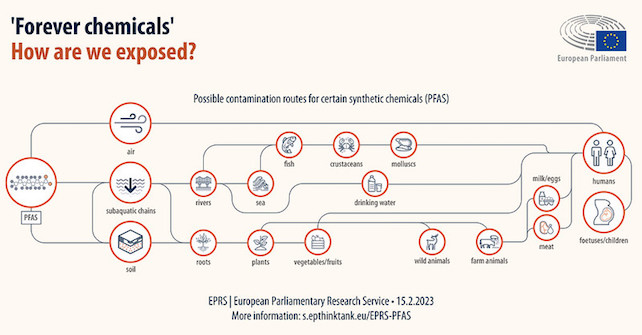'Forever chemicals' are increasingly 'everywhere chemicals,' too.
The durable pollutants are now pervasive in environments around the world, quietly persisting and accumulating. They're also ubiquitous in us, routinely appearing in human blood, lungs, kidneys, and other organs.
Formally known as per- and polyfluorinated alkyl substances (PFAS), the synthetic compounds have been linked with serious health risks, although much of their danger still remains poorly understood, including the specific mechanisms they might use to wreak havoc in our bodies.
In a new study, researchers shed light on the effects of PFAS in human blood, revealing an association between the chemicals and increased risk of cardiovascular disease – along with clues that could help explain how the chemicals exert their effects.
Led by researchers from the German Center for Neurodegenerative Diseases (DZNE) and the Leiden University Medical Center in the Netherlands, the study examined blood samples from more than 2,500 adults in Bonn, Germany, and the Dutch town of Leiderdorp.
PFAS showed up in the blood of nearly every participant, who ranged in age from 30 to 89 years. And while no one is safe from these chemicals, the authors say, their results suggest younger people may face a greater risk.
"We see clear signs of a harmful effect of PFAS on health," says Monique Breteler, director of Population Health Sciences at DZNE. "And we have found that at the same PFAS concentration in the blood, the negative effects are more pronounced in younger subjects than in older ones."
Long prized for their ability to repel water, fat, and dirt, PFAS have been heavily produced and widely used since their debut in the mid-20th century. The PFAS family now includes thousands of distinct chemicals, used in products ranging from cookware and cosmetics to fabrics and dental floss.
While the abundance and diversity of PFAS has complicated efforts to study their health effects, evidence of the potential danger has been mounting.
In the new study, researchers found that PFAS in blood are associated with an "unfavorable lipid profile," or an array of certain fat molecules in the blood that in turn is associated with higher risk of cardiovascular diseases.
"Our data shows a statistically significant correlation between PFAS in the blood and harmful blood lipids linked to cardiovascular risk," Breteler says. "The higher the PFAS level, the higher the concentration of these lipids."
The link was evident even in people with low PFAS levels, the researchers note.

That correlation doesn't prove PFAS caused the difference in lipid profiles, but it is compelling – at least enough to warrant some precautions while the research advances, according to Breteler. "It is a strong argument for stricter regulation of PFAS in order to protect health," she says.
"Even if we don't see an immediate health threat for the study participants we examined, the situation is still worrying," she adds. "In the long term, the increased risk may very well have a negative impact on the heart and cardiovascular system."
The researchers used mass spectrometry to analyze the blood samples, capitalizing on new capabilities that offer unprecedented detail.
"The technology to analyze blood samples with the accuracy required for our research has only become available in recent years," says co-author and DZNE epidemiologist Elvire Landstra.
The study focused on three of the most widespread types of PFAS, known as PFOA, PFOS, and PFHxS. It also identified the levels of 224 different blood lipids, metabolites, and amino acids, giving the researchers a lot of data to work with.
"With this 'untargeted approach' – an intentionally broad approach without a preconceived target – we were able to prove the connection between the PFAS concentration and a problematic profile of fatty substances, so-called lipids," Landstra says.
"These include the well-known cholesterol and various other blood lipids that are known to be risk factors for cardiovascular disease."
More research is still needed to illuminate the link between PFAS and unfavorable blood lipids, including whether and how PFAS might spur these effects, and if the risk really is higher for younger people.
In the meantime, Landstra says, this study goes a long way in building the case against PFAS, and offering a reminder we're all awash in this hidden hazardous waste.
"Our study is the most detailed on this topic to date and the one with the largest database," she says. "Previous studies had already suggested a correlation between PFAS and unhealthy blood lipids, but this link had never been as clear as in our study."
The study was published in Exposure and Health.
